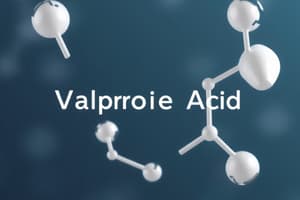Podcast
Questions and Answers
What is the primary focus of pharmacokinetics?
What is the primary focus of pharmacokinetics?
- The study of antidotes in poisoning treatment
- The study of drug abuse and addiction
- The study of ADME at therapeutic doses (correct)
- The study of ADME at toxic doses
What can alter the rate and extent of absorption?
What can alter the rate and extent of absorption?
- Multiple factors, including formulation, bioavailability, and co-ingestants (correct)
- Only the formulation of the product
- Only the dose of the drug
- Only the route of administration
What is the primary difference between pharmacokinetics and toxicokinetics?
What is the primary difference between pharmacokinetics and toxicokinetics?
- The route of administration
- The type of drug being studied
- The dose of the drug being studied (correct)
- The duration of treatment
What can slow or decrease GI absorption?
What can slow or decrease GI absorption?
What can be used to predict the onset of efficacy/toxicity?
What can be used to predict the onset of efficacy/toxicity?
What is the result of concretions/pharmacobezoar?
What is the result of concretions/pharmacobezoar?
How does the formulation of a product affect its absorption?
How does the formulation of a product affect its absorption?
What is the result of opening, crushing, or breaking sustained release products?
What is the result of opening, crushing, or breaking sustained release products?
What is the focus of toxicokinetics?
What is the focus of toxicokinetics?
What is the result of slowed absorption?
What is the result of slowed absorption?
Flashcards are hidden until you start studying
Study Notes
Protein Binding
- Binding capacity becomes saturated, leading to an increase in the free/bound ratio
- An increase in free concentration can result in effects
- Example: 32-year-old with valproic acid overdose, medical student looks up information, and poison center specialist suggests dialysis despite manufacturer's info saying it's not dialyzable
Phenytoin
- 17-year-old with phenytoin toxicity, ataxic and bumping into things
- Level is 26 mcg/ml, higher than usual due to significant weight loss (anorexia) and low albumin level (2.5 mg/dl)
- Free phenytoin level is very high, corrected level of 43 mcg/ml compared to 28 mcg/ml with normal albumin level
Metabolism
- Liver is the major organ involved in metabolism
- Oxidation, reduction, hydrolysis, and conjugation occur through the P-450 enzyme system
- Metabolism can result in:
- Active medication to inactive metabolites
- Active drug to active metabolites + inactive metabolites
- Inactive medication to active medication
- Examples of active drug to active/toxic metabolites:
- Citalopram/Escitalopram, where desmethylcitalopram metabolite is responsible for qt prolongation
- Methanol and Ethylene glycol, where metabolism can be blocked using Fomepizole (4mp) or Ethanol
Elimination
- Irreversible loss of substance from the site of measurement
- Total clearance is the sum of renal clearance, metabolic clearance, and other clearance mechanisms
- Renal elimination involves glomerular filtration, secretion, and reabsorption
- Example: ASA (weak acid), where using NaBicarb can increase elimination by ion trapping and raising plasma and urine pH
Half-life
- Time for the medication concentration to decrease by ½
- Half-life is substance-specific, patient-specific, and influenced by organ function, age, disease states, and other medications
- Half-life relates to the duration of toxicity
Pharmacodynamics vs Toxicodynamics
- Insulin, BB, water, opioid, benzodiazepines, and almost every medication can have different effects at toxic levels
Idiosyncratic Side Effects
- Rare after an overdose
- Risk of idiosyncratic effects is not more common after an overdose compared to a therapeutic dose
Antidotes
- Examples of antidotes carried by EMS/Paramedics:
- Naloxone
- Glucose
- Oxygen
- Atropine
- Physostigmine
- Pralidoxime (2-Pam)
- Examples of antidotes carried by hospitals:
- Cyanide antidote kits
- Snake antivenin (some hospitals)
- Succimer
- Calcium Disodium Versonate
- Antibiotics (for anthrax)
- Specialized resources:
- Snake antivenin (some hospitals)
- HBO
- Botulism immune globulin
- Strategic National Stockpile
Pharmacokinetics vs Toxicokinetics
- Pharmacokinetics: the study of ADME at therapeutic doses
- Toxicokinetics: the study of ADME at doses above the therapeutic dose, which can result in altered absorption, distribution, metabolism, and elimination rates
- Therapeutic dose vs excessive dose: absorption, distribution, metabolism, and elimination can be altered at excessive doses
Studying That Suits You
Use AI to generate personalized quizzes and flashcards to suit your learning preferences.




